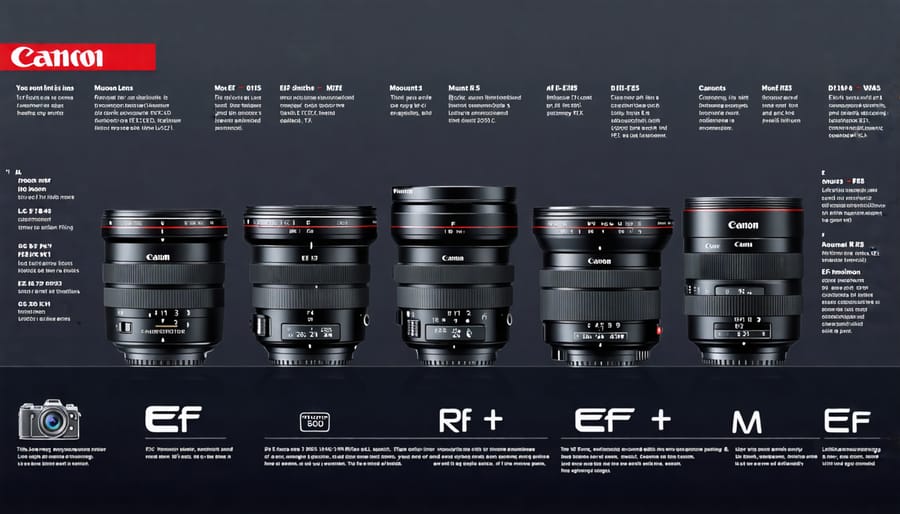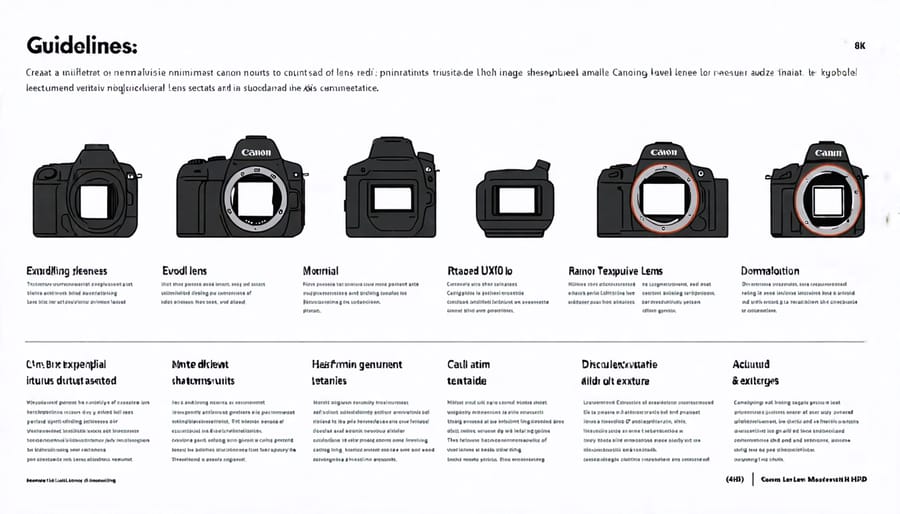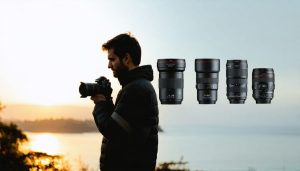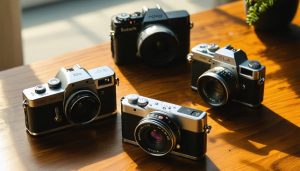
Check your Canon camera’s mount type to ensure lens compatibility. Canon’s EF, EF-S, RF, and EF-M mounts are not universally interchangeable without adapters. EF lenses work on full-frame and APS-C DSLRs, while EF-S are for APS-C only. Mirrorless RF and EF-M lenses are distinct. Refer to your camera manual or Canon’s website to confirm which best lenses for your Canon camera have compatible mounts. Adapters can expand compatibility, like using EF lenses on RF mirrorless bodies, but check autofocus and image stabilization support. When buying lenses, prioritize those specifically designed for your camera’s mount and sensor size to maximize performance and functionality.

Canon Lens Mount Types
EF Lenses
Canon’s EF lenses, introduced in 1987, have a long history and wide compatibility with Canon cameras. These lenses are designed for Canon’s full-frame and APS-C DSLR cameras, as well as their mirrorless cameras when used with an adapter. EF lenses come in a variety of focal lengths and apertures, from wide-angle to super-telephoto, and from fast primes to versatile zoom lenses. They are known for their excellent image quality, durability, and fast autofocus performance. With such a vast selection of EF lenses available, photographers can find the perfect lens for their specific needs, whether they shoot landscapes, portraits, sports, or wildlife. The extensive compatibility of EF lenses makes them a popular choice among Canon shooters.
EF-S Lenses
EF-S lenses are designed specifically for Canon’s APS-C sensor cameras, such as the Rebel series, 60D, and 7D models. These lenses are optimized for the smaller sensor size, providing a more compact and lightweight option compared to their EF counterparts. The “S” in EF-S stands for “short back focus,” which refers to the reduced distance between the lens mount and the sensor. This allows for a more compact lens design that still maintains high optical quality. However, it’s important to note that EF-S lenses are not compatible with Canon’s full-frame cameras, as the smaller image circle may cause vignetting or other issues.
Newer Mounts: RF and EF-M
In recent years, Canon has introduced two new mirrorless camera systems – the EOS R series and the EOS M series. The EOS R cameras use the RF mount, while the EOS M cameras employ the EF-M mount. These mounts are designed specifically for Canon’s mirrorless camera systems, which feature a shorter flange distance (the distance between the lens mount and the sensor) compared to DSLRs. This allows for more compact camera bodies and lenses. RF lenses are not directly compatible with EF-M cameras, and vice versa, due to their different mount types and sizes. However, you can use EF and EF-S lenses on both RF and EF-M cameras with the appropriate adapters, ensuring access to a wide range of high-quality glass.
Determining Camera and Lens Compatibility
To determine if a specific Canon lens is compatible with your Canon camera body, start by identifying the lens mount type. Canon uses several different mounts, such as EF, EF-S, RF, and EF-M. EF lenses work with all full-frame and APS-C Canon DSLRs, while EF-S lenses are designed for APS-C models only. RF lenses are exclusively for Canon’s full-frame mirrorless cameras, and EF-M lenses fit Canon’s APS-C mirrorless bodies.
Once you know the mount type of your camera and lens, consult an online compatibility chart. These charts clearly show which lenses work with specific camera models. If you’re unsure about your gear’s mount type, check the product specifications on the manufacturer’s website or refer to your user manual.
Remember that even if a lens and camera share the same mount, some features like autofocus or image stabilization might not function properly when mixing older lenses with newer bodies or vice versa. When in doubt, it’s always best to test the combination before committing to a purchase.
In some cases, you can use adapters to mount lenses on bodies with different native mounts. However, adapted lenses may have limited functionality or reduced image quality compared to native pairings. Research your options thoroughly before investing in an adapter.

Using Adapters for Older Lenses
Using adapters can be a great way to mount older or different lens types on modern Canon cameras, expanding your creative options. While not all combinations are possible, many adapters allow you to use vintage manual focus lenses or even lenses from other camera systems on your Canon body. However, it’s important to note that using adapters may come with some limitations.
Autofocus functionality is often lost when using adapted lenses, meaning you’ll need to focus manually. This can be a fun challenge for some photographers but may not suit every shooting situation. Additionally, some adapters may not maintain full electronic communication between the lens and camera, so features like aperture control or lens-based image stabilization might not work properly.
Image quality can also be affected when using adapters, particularly if the adapter isn’t precisely manufactured. Slight misalignments or gaps can lead to reduced sharpness, increased vignetting, or other optical issues. Investing in high-quality adapters from reputable brands can help minimize these problems.
Despite these potential drawbacks, many photographers enjoy the creative possibilities and unique character that adapted lenses bring to their work. Experimenting with different lens and adapter combinations can lead to distinctive looks and open up new photographic avenues to explore.
The Importance of Lens Compatibility
Understanding lens compatibility is crucial when building a Canon camera system, as it impacts your ability to maximize your equipment’s potential and adapt to various shooting situations. Investing in compatible lenses not only ensures seamless functionality but also future-proofs your kit. As Canon continues to develop new camera bodies and lens technologies, having a compatible lens collection allows you to easily upgrade your camera without replacing your entire lens lineup. Moreover, lenses that are compatible with a wide range of Canon cameras tend to retain their value better in the long run, making them a smart investment for photographers looking to build a versatile and long-lasting kit. By prioritizing lens compatibility, you can create a flexible, adaptable camera system that grows with you and your evolving photographic needs.
Conclusion
In conclusion, while Canon offers a wide range of lenses, not all are compatible with every Canon camera. The key factor is the lens mount type, which must match the camera’s mount to ensure proper fit and functionality. Most modern Canon DSLRs use the EF mount, while their mirrorless cameras utilize the newer RF mount. Older Canon cameras may have different mounts like FD or EF-S. To determine compatibility, always check your camera’s specifications and the lens mount type before making a purchase. In some cases, adapters can enable cross-compatibility, but it’s essential to research their limitations. By understanding these compatibility considerations, you can make informed decisions when building your Canon lens collection and unlock the full potential of your photography gear.




















